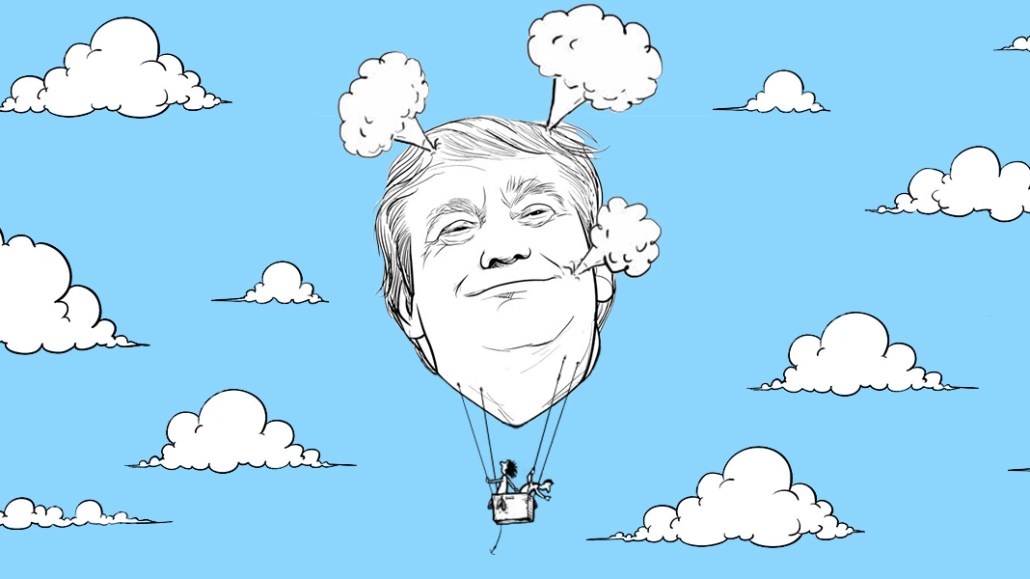‘Our president is often not brand-safe’: Why publishers struggle to monetize the Trump bump

Viral stories about Donald Trump are great for comScore bragging rights, but they can be difficult for publishers to monetize.
It’s a sign of the times that advertiser demands of brand safety sweep up news relating to our current politics. On average, the 10 largest buy-side platforms are placing ads on 11 percent fewer sites this year compared to last year, according to MediaRadar. Ad buyers are also increasingly using keywords and sentiment analysis to create custom categories of content to avoid, with a focus on reducing their exposure to Trump.
For example, rather than simply blacklist CNN out of fear of running ads against content about Russia’s influence on the U.S. presidential election, an advertiser could block any article that contains a combination of the words “Trump” and “Russia” from its campaign. In this year’s third quarter, ad tech firm Sizmek’s semantic ad-targeting platform Peer39 saw a 150 percent year-over-year increase in the number of clients that created custom categories to keep their ads off specific types of content. One of the most popular subjects that advertisers created categories around to steer clear of was Trump, said Mike Caprio, chief growth officer at Sizmek.
“Believe it or not, our president is often not brand-safe,” quipped Ken Van Every, senior business development manager at demand-side platform DataXu.
DSPs culling long-tail websites falls in line with large brands like Procter & Gamble, Unilever and JPMorgan Chase slashing the number of sites their ads appear on. This tactic helps ad buyers avoid racist publishers and “fake news” websites that originally sparked the outcry for brand safety last year.
But political tensions have reached a point where some media buyers are blacklisting even mainstream news outlets like Fox News. Another factor that has made ad buyers more vigilant about brand safety is that due to stories like the YouTube brand pullouts and the Russian presidential influence campaign, ad tech crossed into the mainstream. This gave high-ranking marketers a greater awareness about the shadier aspects of digital ad targeting, which made brands less likely to be willing to risk their ads appearing against controversial political content, said Marcus Pratt, vp of insights and tech at ad agency Mediasmith.
Advertisers’ increased sensitivity to politics makes it harder for publishers to capitalize on Trump-driven bumps in traffic through programmatic exchanges. A source from a business publisher requesting anonymity said so few large brands bid on the impressions associated with the publisher’s Trump articles that trolls who target Trump stories are able to outbid brands and place inflammatory memes about former Secretary of State Hillary Clinton and former San Francisco 49ers quarterback Colin Kaepernick (two favorite targets of the far-right) on the publisher’s site.
The memes are a terrible look for the publisher’s brand, the source said. They also result in a lost revenue opportunity if ad ops removes ads from articles to get trolls off the site.
Even for publishers that are able to steer clear of junk ads on programmatic exchanges, Trump’s unpredictability is hard to directly sell ads against, said a news publisher exec requesting anonymity. Unlike major events like Election Day when the publisher can predict that traffic will be high, direct salespeople who work with a 60-day lead time can’t predict when a story about Trump’s random tweetstorms will go viral and attract an onslaught of users. For these viral stories, the publisher sells the inventory programmatically, where CPMs are significantly lower than direct buys.
While forgoing the chance to obtain discounted inventory from a premium publisher on an open exchange might seem like a missed opportunity for an advertiser, blocking polarizing political content helps CMOs avoid getting called out by screenshot activists for ads appearing beside controversial content. This trend makes it more difficult to sell political inventory programmatically, but it doesn’t necessarily make it harder for publishers to make money on political content in general.
On direct buys, where an advertiser knows what sites its ads will run on, publishers can more easily sell ads against political content. Execs from Politico, New York magazine and PopSugar — which sell the vast majority of their inventory direct — said brands aren’t asking them to keep their ads off of articles about Trump.
“A lot of publishers are chasing politics coverage for the impact and can’t monetize it,” said Politico President Poppy MacDonald, who noted on the Digiday Podcast that she’s not worried about the waning Trump bump. “But Trump hasn’t changed what we do or our business model.”
More in Media

From sidelines to spotlight: Esports events are putting creators center stage
Esports events’ embrace of content creators reflects advertisers’ changing priorities across both gaming and the wider culture. In the past, marketers viewed esports as one of the best ways to reach gamers. In 2025, brands are instead prioritizing creators in their outreach to audiences across demographics and interest areas, including gaming.

Condé Nast and Hearst strike Amazon AI licensing deals for Rufus
Condé Nast and Hearst have joined the New York Times in signing a licensing deal with Amazon for its AI-powered shopping assistant Rufus.

Media Briefing: AI payouts may be entering a new era
AI compensation is evolving — and new models, not just publisher demands, are driving the shift beyond flat-fee licensing.








